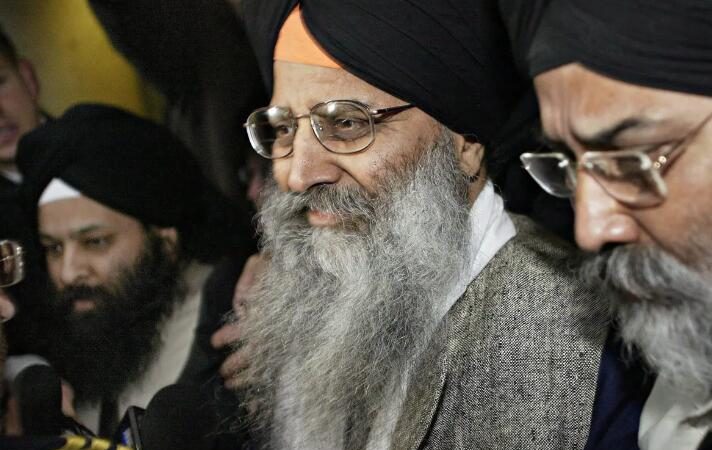Police identify suspect vehicle linked to killing of Ripudaman Singh Malik

Vehicle waited for Malik outside family business before he was shot, IHIT says
Police have identified a vehicle linked to the targeted killing of Ripudaman Singh Malik, a man who was acquitted in the Air India bombings and shot dead on Thursday.
The Integrated Homicide Investigation Team (IHIT) released footage on Friday of a white Honda CRV believed to have been used by the person, or people, responsible for the killing.
Police said the SUV waited for Malik on Thursday outside his family business, Papillon Eastern Imports, located at 8236 128 Street. IHIT said the vehicle parked around 7 a.m. PT and waited there for more than an hour.
Malik, 75, was shot “several times” at 9:27 a.m.
Shortly after, the SUV was found on fire in the area of 82 Avenue and 122A Street, roughly two kilometres away.
Investigators said they were still canvassing for CCTV footage and couldn’t say whether the shooting itself had been caught on video.
Anyone with dashcam footage from the area of the shooting between 7 and 9 a.m. on Thursday, or who might have seen the CRV and the people inside, is asked to contact IHIT.
Malik’s family ran the Papillon clothing company, which is based in the building where he was killed. His red Tesla was visible in the parking lot after the shooting.
At a news conference Friday, IHIT said investigators were still confirming whether the suspect vehicle was stolen. Sgt. David Lee said he could not confirm how many people might have been in the SUV to avoid tainting any witnesses’ memories.
Air India case
Malik and his co-accused, Ajaib Singh Bagri, were acquitted in 2005 of mass murder and conspiracy charges related to the pair of bombings in 1985 that killed 331 people, mostly from the Toronto and Vancouver areas.
In recent years, Malik served as chairman with Khalsa School and managed two of the private schools’ campuses in Surrey and Vancouver. He was also president of the Vancouver-based Khalsa Credit Union, which has more than 16,000 members.

IHIT confirmed Malik’s identity on Thursday and acknowledged his high-profile link to the bombings, but said officers were still working to determine a motive.
“We understand this is a high-profile, international story. However, we urge [people] not to speculate as to the motive as our homicide investigators will be following the evidence,” said Lee.
-
TIMELINE
A timeline of the Air India case, from the bombings to the death of an old suspect
The death of Malik, an influential businessman who had significant influence within Canada’s Sikh community, drew mixed reactions on Thursday. Some said the community had lost a respected advocate, while others thought only of the bombings.
“I was surprised when I heard the news. It just brings back and triggers all the memories of the last 37 years and the pains and the failures of the last 37 years,” said Deepak Khandelwal, an executive with the Air India Victim’s Families Association who lost two sisters in the bombings.
Nishi Thampi, whose mother died in the bombing, said Malik’s death made her feel as if the chance to get answers about what happened in 1985 was farther away.
“We’ve lost an important link to the source of truth,” she said.
Malik had a wife and five children. Asked whether Malik’s family is co-operating with investigators, Lee said he couldn’t provide details but that police were in contact.
“I can’t discuss exactly what the family’s spoken with us about, but … we are in contact to find out what support they require,” Lee said.
Crown lawyers alleged the bombing was a terrorist attack against state-owned Air India, an act of revenge by B.C.-based Sikh extremists against the Indian government for ordering the army to raid Sikhism’s holiest shrine, the Golden Temple in Amritsar, in June 1984.
Only one man was convicted in relation to the crime. Inderjit Singh Reyat served 30 years for lying during two trials, including Malik’s, and for helping to make the bombs at his home in Duncan, B.C.
Malik, then 58, and Bagri, then 55, were acquitted after a highly publicized trial that stretched on for years.
Justice Ian Josephson found the Crown’s key witnesses, who testified they heard the two defendants confess, were biased and unreliable.
The national Air India inquiry later concluded Talwinder Singh Parmar was the mastermind behind the deadly mid-air bombing. Parmar, 48, was shot and killed by police in India in 1992.
Another suspect, Hardial Singh Johal, died in November 2002.
Related News
Trump signs executive order to speed up deepsea mining permits
U.S. President Donald Trump on Thursday signed an executive order aimed at boosting the deepseaRead more
See the Ukraine war ceasefire proposals put forth by the Trump administration
Reuters has seen the text of a set of proposals to end Russia’s war inRead more
